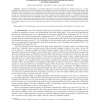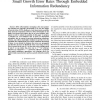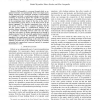102
Voted
NC
2008
15 years 22 days ago
2008
Molecular self-assembly is a promising approach to bottom-up fabrication of complex structures. A major impediment to the practical use of self-assembly to create complex structure...
86
Voted
CORR
2010
Springer
15 years 27 days ago
2010
Springer
We consider the problem of fault-tolerance in nanoscale algorithmic self-assembly. We employ t of Winfree's abstract Tile Assembly Model (aTAM), the two-handed aTAM, in which...
130
Voted
DATE
2009
IEEE
15 years 1 months ago
2009
IEEE
Abstract--DNA self-assembly is emerging as the most promising technique for nanoscale self-assembly as it uses the simple, yet precise rules of DNA binding to create macroscale ass...
109
click to vote
DNA
2006
Springer
15 years 4 months ago
2006
Springer
We study the times to grow structures within the tile self-assembly model proposed by Winfree, and the possible shapes that can be achieved. Our earlier work was confined to the g...
95
Voted
CIE
2010
Springer
15 years 5 months ago
2010
Springer
The Tile Assembly Model is a Turing universal model that Winfree introduced in order to study the nanoscale self-assembly of complex (typically aperiodic) DNA crystals. Winfree ex...
120
Voted
DNA
2003
Springer
15 years 6 months ago
2003
Springer
Abstract. Self-assembly is a process in which basic units aggregate under attractive forces to form larger compound structures. Recent theoretical work has shown that pseudo-crysta...
107
Voted
ICRA
2008
IEEE
15 years 7 months ago
2008
IEEE
Abstract— Self-assembly is a process through which an organized structure can spontaneously form from simple parts. Taking inspiration from biological examples of self-assembly, ...



